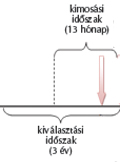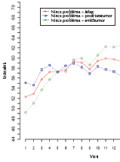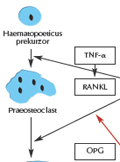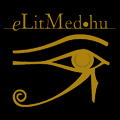The eLitMed.hu medical portal uses computer cookies for convenient operation. Detailed information can be found in the Cookie-policy.
LAM KID - 2012;2(04)
Content
[Adherence of Hungarian postmenopausal women with osteoporosis]
[INTRODUCTION - Osteoporosis is defined as a loss of bone tissue and bone mass that leads to a compromised trength and quality of bones and thus to an increased risk of fractures. In many women, menopausal hormonal changes are associated with an increased bone loss. This population has postmenopausal osteoporosis. The essence of osteporosis treatment is the adequate calcium and vitamin D supplementation, which, if needed, might be combined with drug therapy to inhibit the process of bone loss. METHODS - We assessed the adherence to therapy of Hungarian patients and its effect on the risk of bone fractures, using data recorded by the National Health Insurance Fund Administration between 2004 and 2010 (n=223068, mean age: 69.9 years). We performed a statistical analyses of the available data. Medication possession ratio (MPR) for each treatment and the ratio of patients receiving continuous treatment in the study period (for 12, 18 and 24 months) were estimated. Medication persistence was investigated using Kaplan-Meier survival analysis. A multivariate Cox proportional hazard model was used to determine the factors influencing the risk of fracture. RESULTS, CONCLUSION - The results of our study show that medication adherence to treatment is low among Hungarian patients [mean MPR: 57.9%; 95% CI (57.7%- 58.0%) and persistence rate: 32.4%; 95% CI (32.2%-32.6%) in the first year]. These parameters are substantially influenced by the administration route and the frequency of treatments [mean MPR ranged 41.5%- 100% and persistence rates ranged 18.8%- 100% in the first year, differences between subgroups were significant (p<0,05)]. Our compliance as well as persistance studies showed that parenteral administration had more beneficial effects. Confirming our preliminary hypotheses, the improvement of patient compliance significantly reduced fracture risk (good compliance was defined as MPR>80%, which was associated with RR: 0.57, p<0.05 for fracture risk). Further improvement might be achieved by parenteral administration [RR for fracture risk 0.60 compared with non-compliant patients and 0.44 compared with compliant subgroups treated with oral and parenteral medications (p<0.05)].]
[Effect of zoledronic acid treatment on pain and quality of life in patients with metastatic bone disease suffering from breast and prostate cancer - Multicenter, prospective, observational study]
[INTRODUCTION - Metastatic bone disease is frequently associated with breast and prostate cancer. Bisphosphonate treatment of bone metastases is palliative: its primary goal is to relieve pain, while it's also important to decrease the risk of bone fractures, prolong survival and maintain physical activity of the patients. Pain is the most common symptom of bone metastases. PATIENTS AND METHODS - In total 845 patients were enrolled in our open, multicenter, prospective, observational study, the first of its kind in Hungary. The agent tested was zoledronic acid (Zometa®). Duration of the study was 20 months and its primary goal was to assess the correlation between pain and quality of life during the treatment of patients with bone metastases from breast or prostate carcinoma. RESULTS - During the 18 months of the study, the average intensity of pain, measured on the visual analog scale showed a 42% reduction (p<0.0001). By the end of the 18. month, the ratio of patients free of symptoms has increased by 15% and the number of patients with substantial complaints has decreased by 73%. CONCLUSION - Our study supports the observation published in the international literature that in patients with bone metastases from breast and prostate cancer, zoledronic acid treatment is beneficial for reducing pain and thus for improving quality of life.]
[The effects of targeted therapies on bones]
[Arthritis is associated with local as well as generalised bone loss. It is likely that similar inflammatory/immunological factors contribute to both types of bone loss. Today, the main targets of arthritis therapy are proinflammatory citokines (TNF-alpha, IL-1, IL-6, in the future IL-17) and the inhibition of B and T cells. All biological therapies have been proved to slow down the development of focal joint destruction. TNF-inhibitors in particular have been demonstrated to have a beneficial effect on generalised osteoporosis. In ankylosing spondylitis, generalised osteoporosis and locally increased bone formation occur at the same time, creating a controversial situation. Further studies are needed for a better understanding of the effects of targeted therapy on bones.]
[Everyday decisions regarding osteoporosis treatment]
[Efficient, new medicines as well as recent scientific results have substantially changed the options and daily practice of osteoporosis treatment. Besides the indicated duration of therapies, their indication has also changed in several key points, and the range of possibilities for switching therapies have expanded. Despite the availability of a steadily increasing number of data, large-scale studies do not always help making therapeutic decisions, so we have to rely on professional protocols and our own experience, as well as on logical thinking. Moreover, we also have to observe financial regulations. This summary is intended to serve as a guideline for the most important decision situations from the initiation of therapy until its cessation.]
[The importance of balneotherapy in osteology]
[The authors overview the role of hydro-and balneotherapy in osteology. AsHungary is very rich in thermal-mineralwater, this kind of therapy has a greatimportance in the rehabilitation of locomo-tor diseases. In the past years, an increasingnumber of data have been published aboutthe immunomodulatory, metabolic andanalgesic role of hydro- and balneothera-py. Although balneotherapy’s mechanismof action has not been clarified yet, a num-ber of reviews and metaanalyses havefound that hydro- and balneotherapy havea beneficial effect on locomotor diseases.The majority of these articles - many ofthem written by Hungarian authors - dis-cusses the treatment of arthrosis. Further-more, an increasing amount of data isavailable on calcium supplementation withmineral water. In this paper, we discuss therole of hydro- and balneotherapy in thetherapy of osteological diseases, on thebasis of the available evidence. ]
1.
Clinical Neuroscience
[Headache registry in Szeged: Experiences regarding to migraine patients]2.
Clinical Neuroscience
[The new target population of stroke awareness campaign: Kindergarten students ]3.
Clinical Neuroscience
Is there any difference in mortality rates of atrial fibrillation detected before or after ischemic stroke?4.
Clinical Neuroscience
Factors influencing the level of stigma in Parkinson’s disease in western Turkey5.
Clinical Neuroscience
[The effects of demographic and clinical factors on the severity of poststroke aphasia]1.
2.
3.
4.
5.










